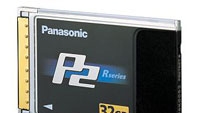Panasonic lowers P2 card price

Even though many customers have to use adaptors to access the data and the form factor is expensive when compared to third-party media, Panasonic said it is staying with the 5.25in PCMCIA format, the support for which has virtually disappeared from laptop computers, particularly used in newsgathering, for its P2 solid-state recording system. However, it is dropping the price.
In discussing its new products for the upcoming NAB Show in April that “improve the cost of ownership,” the company has announced an average 20 percent decrease in cost for its P2 cards, stating that the 64GB card is now $695 (30 percent decrease); the 32GB $480 (25 percent decline); and the 16GB cards costs $380 (15 percent decrease). In 2007, the 32GB P2 card (model AJ-P2C032RG) had a suggested list price of $1650.
The company said 64GB will be the biggest capacity card made for a while because customers have said 320 minutes of 100Mb/s HD record time is “the right size” for most video shoots. However, the company clearly wants to chip away at the lingering objections some professionals have about the P2 system.
“The professional video industry has wholeheartedly embraced solid-state recording, and we like to think we initiated that movement (with P2 in 2004),” said Joe Facchini, vice president of sales and product management for Panasonic. “For all of our solid-state systems, we’re now focused on improving workflow and eliminating barriers to entry (to our P2 system). We’ve heard from our customers that P2 card pricing remains a barrier to entry, so we’re addressing that in an aggressive way.”
Some professionals say that the form factor “gets in the way” of true file-based production. When you need more storage in the field, it's nice to be able to go into an electronics store and buy more SD cards. Panasonic, however, sees otherwise.
“We’re committed to the large number of customers out there with cameras with PCMCIA slots in them,” said Mike Bergeron, technical liaison for third-party partnerships at Panasonic. “We now have adapters going to USB 3.0, and we see that as the way for customers to keep up with the changes in PCs. We’re already achieving a greater throughput than the PCMCIA spec is getting.”
Facchini added, “It doesn’t mean that the format will never change, but it won't change unless there’s a reason for it to change.”
The professional video industry's #1 source for news, trends and product and tech information. Sign up below.
Each P2 card consists of four SD memory cards, packaged in a die-cast frame that weighs 0.099lbs and offers four times the capacity and four times the transfer speed of a single SD card. The P2 card is reusable, up to roughly 1000 times, and connects with laptops and nonlinear editing systems via a special adapter or a Panasonic P2 player hooked up to a computer.
P2 cards include microcomputers with their own processors, firmware, a RAID controller and zero-fault, solid-state memory chips. The card can be used to manage the data files, and it even does a write-verification step for every byte of memory that gets written to the card, thus assuring fault-free operation. Early P2 cards were manufactured using actual SD memory cards in a striped RAID array. The current generation of E-Series P2 cards doesn’t use individual SD memory cards; it uses multiple core memory components. The card also uses the FAT32 file system, which makes the card compatible with both Macintosh and Windows systems.
Panasonic said the P2 card is resistant to impact, vibration, shock, dust and environmental extremes, including temperature changes. It operates in temperatures from 4 degrees below zero to 176 degrees Fahrenheit and can be stored in temperatures from 40 below to 176 degrees Fahrenheit. The solid-state P2 memory card can transfer data at speeds up to 640Mb/s, allowing news crews to begin working as the scene is being shot or very soon after.
With five 32GB P2 cards installed, those using a Panasonic AJ-HPX3000 or HPX2000 P2 HD camcorder, for example, can record up to 2.5 hours (more than three hours in 24p) in AVC-Intra 100 or DVCPRO HD and 5 hours (more than 6.5 hours in 24p) in AVC-Intra 50 or DVCPRO 50.
Panasonic has been sensitive to the inhibitive cost of the media. In 2009 the company introduced a line of more affordable P2 cards, called the E-series, which offer improved data transfer rates (up to 1.2Gb/s) and slightly shorter lifespan than the first-generation P2 system. The E-Series cards can last five years when recorded once daily at full capacity and up to 10 years when used at half capacity.
At the 2011 NAB Show, Panasonic will introduce several new products to fill out its P2 workflow, such as a new three-slot player/recorder and a P2 deck with 3-D synchronized record/playback, native 24p recording in variable frame rates and 24-bit, four-channel audio recording in AVC-Intra 100/50. Panasonic also promised a “big announcement in acquisition,” but said it won't get specific until the show.
